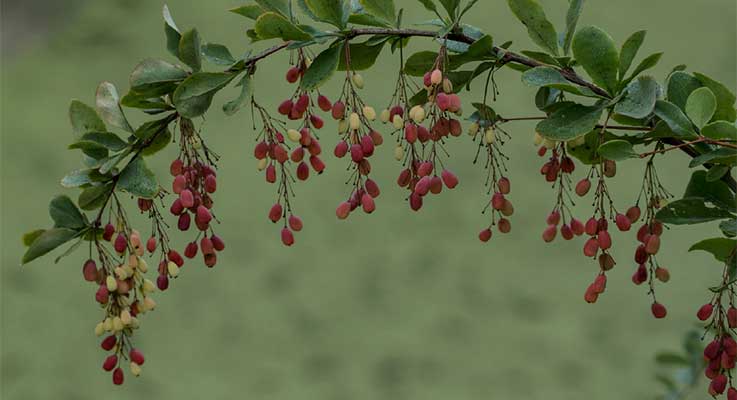
One of the plant varieties that withstood this summer’s heat was Berberis jamesiana ‘Exuberant’. The deciduous shrub sports abundant hanging clusters of fruit that begin pale yellow and gradually turn vivid red-orange. Photo by Dave Eckerdt.
Despite a summer that shattered records for heat and lack of rain, some plant varieties thrived.
As summer ends and I walk around my garden, it is interesting to observe which plants are still looking good. With a summer that shattered records for heat and lack of rain, many plants suffered.
During visits with other gardeners, I asked them which plants received minimal or, in some cases, no summer water. Following are a few selections that beat the heat.
Several years ago, I planted three single trunk Olea europaea ‘Arbequina’ olive trees in an area between our house and a neighbor’s. This area does not have particularly good soil, is on a slight slope, gets intense summer sun and is exposed to the weather, regardless of what it might be, with no protection.
The first winter after planting, the temperatures dipped into the teens; in the spring it was obvious that the trees had suffered cold damage. With the top growth either dead or dying, I was prepared to remove all three trees. However, I soon saw new growth coming up from around the base and decided to cut the trunk to ground level and see what happened.
A year later, I have three multi-branched olive trees that came through the summer looking splendidly and had absolutely no supplemental water.
For a drought-tolerant plant that puts on a magnificent display of large, white crinkled flowers in the spring, Romneya coulteri (Matilija poppy) is hard to beat. A native of Southern California and northern Baja, Matilija poppy will grow quite well here in spite of our wet winters as long as it has adequate drainage.
I have seen Matilija poppy growing — and thriving — under some very adverse conditions. My neighbor has had a large plant near the road for many years, and this past summer it received no water. It spreads by rhizomes, but I have never seen it become invasive in gardens here. The stems can be cut to the ground in the fall, and if a gardener wants to start some new plants or give some away, this is the time to do it.
Romneya is difficult to transplant, so I would suggest starting more plants than are needed because some will surely die. To start a new plant, cut a piece of the rhizome with roots attached and, being careful to keep some soil around it, transplant the cutting into the new location immediately. Successful transplanting is difficult to achieve and I wish you the best of luck.
Dedicated in 1899 by the Oregon Legislature as the official state flower, Mahonia aquifolium (Oregon grape) is a native plant that is often appropriate for home gardens.
While the leaves tend to be prickly like holly, Oregon grape has many positive attributes. It is evergreen, flowers in early spring with clusters of yellow flowers and is a favorite early season food source for hummingbirds.
Purple clusters of fruit follow the flower, and while these fruits can be cooked into jam, they are usually left on the plants for ornamental purposes and as a source of food for birds.
Oregon grape requires little or no supplemental water once established, and there are many selections to choose from with some staying small (2–3 feet) and some growing up to 6 feet or more.
A discussion of low water garden-worthy plants would not be complete without mentioning Arctostaphylos (manzanita). Native to California and Oregon, some Arctostaphylos varieties can be featured as a specimen garden plant.
With their copper to red colored bark, they make an especially beautiful plant in the winter with a light shining up from the base. The clusters of light pink to white flowers, which appear in late winter/early spring, resemble the flowers on a blueberry plant.
The early spring flowers make it another good plant for attracting hummingbirds, and the berries that follow are a good source of food for other birds. There are many different varieties to choose from; most gardeners select those with the most vivid bark coloring. Once established, manzanita requires very little supplemental watering.
The genus Berberis (barberry) has an extensive variety of plant textures and foliage colors, and while most have thorns, they can still be easily worked into most home garden landscapes. There are plants with dark burgundy foliage, bright golden yellow foliage and all shades in between. Some plants are very spiny and make a good barrier between property lines.
An added bonus to barberry is that the foliage colors change in the fall. Berries tend to range in color from red, pink, coral and salmon, but most are dark purple to blue-black and all attract an assortment of birds.
I would be remiss without mentioning Kniphofia. At one time, these plants went by the common name of red hot poker because of the color of the flower. However, with all of the new introductions, that name is no longer appropriate. Now there are flowers of red, coral, bright yellow and white.
These South African natives have adapted well to our Pacific Northwest climate and with good drainage they make excellent garden plants with limited water requirements. Plant them in full sun and in groups for the best effect. They are hummingbird magnets, too.
There are many more plants that can survive and thrive on a low-water regimen. I mentioned these six plants because most gardeners might be somewhat aware of them but not realize their low water requirements. A garden center could make a display featuring these plants and provide customers information sheets with tips on growing.
I believe that after the summer season we have had, there will be an increased interest in plants that have low water requirements, yet also look good in a home garden.


